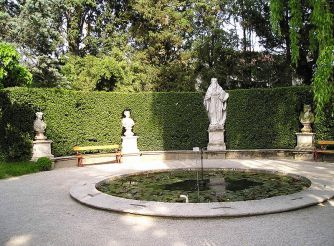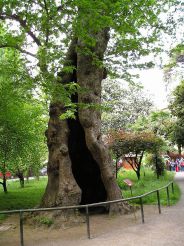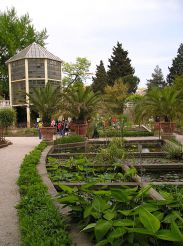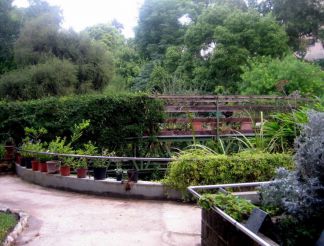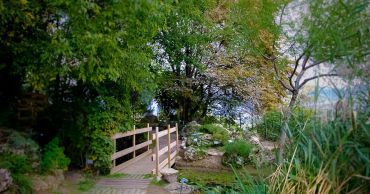Botanical Garden, Padua
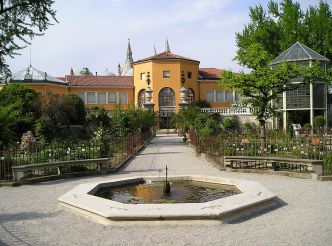
Botanical Garden in Padua (Italy) is considered to be the oldest in the world and with the permanent university garden. Founded for growing medicinal plants and called the "Garden of Pharmacists", it gradually became a gem among similar establishments. Various scientific works continue here today, as well as the conservation of endangered plant species. The garden is on the UNESCO World Heritage List as a delightful example of how to arrange the kingdom of flora in human cities.
History of the garden
The garden was founded in 1545 by decree of the Senate of the Republic of Venice at the local university for the cultivation of plants, which were used for the preparation of "simple" medicines. Thanks to the enormous influence of the Venetian merchants and access to the sea routes, in 1547 the collection included about 1800 plants. In 1552, the garden acquired the characteristic shape of a square in a circle, and was surrounded by a wall to protect it from thieves. Architects Andrea Moroni and Daniele Barbaro worked on the creation of the garden. Over the following centuries, the garden was modernized and enriched with new exotic plants.
In 1704 four iron gates were erected, with superstructures in the form of pineapples. Until the end of the 18th century fountains were established, for watering the garden, statues of Solomon and Theophrastus, ornaments from Istrian stone on the walls. In the first half of the 19th century, several greenhouses were built, one of which was preserved. At the same time, a student botanical theater was created, which is also used today for classes. Three different sundials were installed: in the form of a cube, a cylinder and a sphere. In 1997, the Botanical Garden of Padua was included in the UNESCO World Heritage List.
Collections of garden
The Botanical Garden is spread over a relatively small area of 22,000 square meters. But, nevertheless, it has more than 6000 plants from 3500 different species. And here everything is decorated with such love and taste that staying in the garden will bring pleasure to everyone: from a scientist who appreciates biological diversity and valuable specimens, to an ordinary man who will leave this place with a gaping mouth from the beauty he has seen.
Really old and exotic trees can be found in the garden: palm trees, Ginkgo bilŏba, Eastern Platanus, Magnolia, Himalayan cedar, Bald cypress, Vitex (Abraham tree), and endangered plant – Metasequoia. The garden has 4 collections of plants:
- Insectivorous plants. Everyone heard about these exotic plants. They are interesting, unusual, and cultivated since the 19th century in garden greenhouses.
- Medicinal and poisonous. This collection is the oldest and represents a direct continuation of the original activity of the garden. In the past, simple medicines were prepared from plants presented here, and there also are those that are used in medicine today.
- Plants of the Euganean Hills. Collection of local Mediterranean flora. It also presents a lot of rare species preserved from the disappearance due to the development of agriculture.
- Imported plants. In this collection there are many plants that are now familiar to us, but in the past they were not represented in Europe. They come from different corners of the globe, and here they were actively cultivated and acclimatized. Among them are lilac, jasmine, sunflower, sesame, potatoes.
Five natural environments with characteristic plants are reproduced in the botanical garden: Mediterranean, alpine meadows, fresh water plants, dryland plants, and a tropical greenhouse with delicious orchids. Also, the garden demonstrates examples of ecosystems of different climatic zones. Here you can see separately the history of the human use of plants in certain regions, such as coffee, cocoa, mango, cycad and cacti.
Interesting Facts
- The oldest tree in the garden is the palm tree of St Peter. The tree was brought here in 1585 and is now better known as Goethe's palm tree. It is said that it was the source of inspiration for writing the work "Metamorphosis of Plants" after visiting the garden in 1786.
- In the garden, the cut-up trunk of the elm was preserved. It is a wonderful example for determining the age of a tree by rings.
- The garden has a special program for the blind and people with visual impairments. In its framework, plants with a characteristic aroma and labels in Braille are presented.
- In the laboratories of the Botanical Garden, scientific research is still continuing. Research of scientists have made a significant contribution to the development of medicine, botany, pharmacology and ecology.
How to get there
The botanical garden in Padua is located almost in the center of the city, on Via Orto Botanico, 15. It is an ancient Italian city, located 40 km west of Venice. Near the garden there is the famous Prato della Valle square, the Basilica of St. Anthony and the Abby of Saint Giustina. The city itself can be reached from Venice by buses of FSBusItalia and by train. From the station to the garden you can take the tram (route SIR1), go out at the Santo stop. Also on the bus, routes M, AT, U12, Businello stop.
Opening hours:
- From November to March – from 9:00 to 17:00.
- April and May – from 9:00 to 19:00 every day.
- From June to September from 9:00 to 19:00.
- In October from 9:00 to 18:00.
Sundays and public holidays are days-off. The ticket office closes 45 minutes before the end of work. Phone number: (+39) 049 8273939.
Entrance: a full ticket – 10 euros, with discount (children, students) – 5 euros. A family ticket for 2 adults and up to 3 children costs 22 euros. For children under 6 and students of the local university – for free. Data on March 2018.



